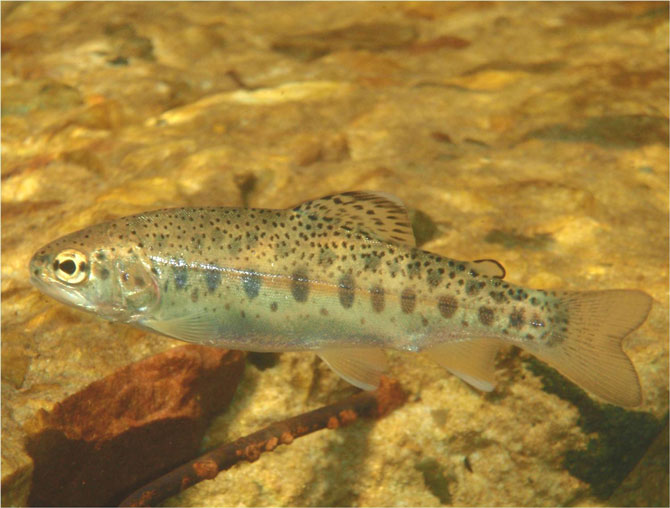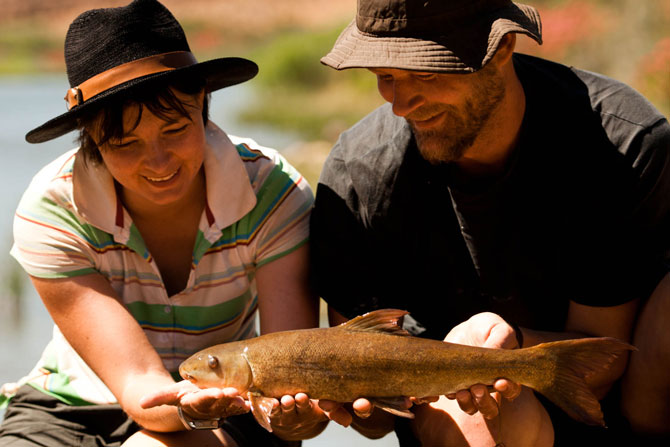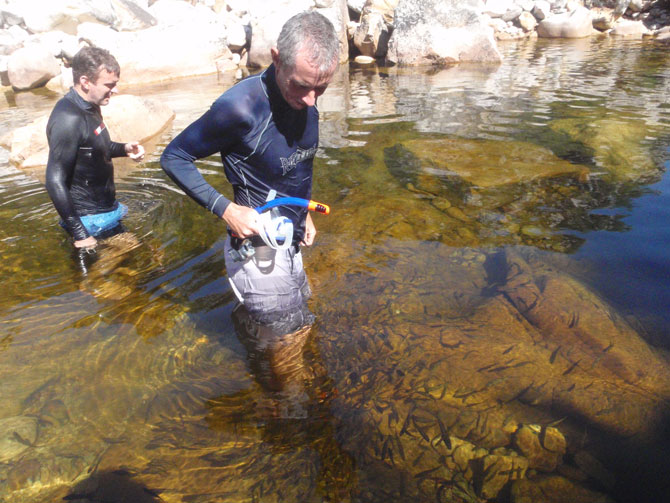The sun reaches its apex as the faint familiar gurgle of water over rock greets my ears. It has been a hot and thorny hike up the kloof through pathless fynbos. Before that, a long and sweaty drive through townships and farmlands, and before that, the incessant clockwork hum of modern-day city life. But now, having finally arrived at the water’s edge and the home of special fish, a different kind of rhythm starts to take over.
I pause for long enough to breathe it in and then allow my body to free fall. A thunderous splash, and then silence. I open my eyes and peer through the goggles, swimming deeper down, down into darkness. I grab hold of a rock the size of a rugby ball, flip over onto my back and peer up at the silhouette that starts to take shape above. Just the cool swirling of water at first, but as the debris settles the shapes begin to move. Appearing from nowhere and from everywhere, clusters then swarms of them start dancing, weaving and frolicking through the strings of silvery bubbles. They are the redfin minnows, the spirits of these mountains. I close my eyes, let go and savour the weightlessness that lifts me gently up, up back towards the light.

This river is not like other rivers. This is one of the last large rivers in the Cape Floristic Region (CFR), at the south-western tip of Africa, where native fish still swim free and untroubled, as they have done for millions and millions of years. A few hundred meters downstream there is a small waterfall, and below that there are no minnows, only introduced bass. Brought here from the northern hemisphere a century ago to provide fishermen with a respectable quarry, predatory non-native fishes like bass and trout have invaded countless rivers and pose the single greatest threat to remaining indigenous fish populations in the CFR.

All of the 12 species of redfin minnow, the most widespread group of freshwater fishes in the CFR, are endemic, and nine of these species face a serious risk of extinction. Redfin minnows evolved in the absence of large predatory fish and consequently have not developed adaptations necessary to cope with this new predatory threat. It appears that their naiveté in the presence of invasive predators renders them especially vulnerable to predation and has contributed to their rapid disappearance from many of the region’s streams.
The fate of the fynbos fish now lies in our hands. We need to focus on safeguarding the remaining populations against further devastation. To achieve this there must be a concerted effort to prevent new alien fish introductions above the waterfalls and weirs that function as barriers, especially in places where critically endangered species occur upstream. To this end, there is an urgent need to boost education and awareness around the issue of freshwater fish conservation in the CFR, and the recently launched Cape Critical Rivers project is an encouraging step in the right direction. Supported by the international Save Our Species campaign, the CCR project is working with land owners and other stake holders to protect two of the CFR’s most threatened freshwater fishes – the Clanwilliam sandfish and the Barrydale redfin.

In some cases native species have been reduced to such small sections of river that they will unlikely be able to cope with future environmental changes. In such situations the chances of a species surviving can be greatly improved by increasing habitat through the clearing of alien fishes from a section of river. A recent and exciting project coordinated by local conservation agency CapeNature has demonstrated that alien fish can be successfully eradicated, and that this conservation tool can be extremely effective in reeling our threatened fish species back from the edge of extinction. Unfortunately, management interventions like this do not come cheap, and with several species still on shaky ground, our work in this area is far from done.

In just one lifetime our freshwater fishes have disappeared from the vast majority of their natural habitat, but the damage has been done underwater in remote mountainous areas that fall out of site of the public eye. It is now time for us to stand up, take notice and fight on behalf of these ancient, silent creatures of the streams.
REDFIN // a conservation story from Otto Whitehead.
ALSO READ: Swimming blind
To comment on this story: Login (or sign up) to our app here - it's a troll-free safe place 🙂.![]()






